Reconstructing the tropical Pacific SST with PAGES2k and GraphEM#
Expected time to run through: ~0.5 hrs
In this section, we illustrate the basic workflow of the Graphical Expectation-Maximization algorithm (GraphEM, Guillot et al., 2015) with cfr, conducting a reconstruction experiment with the PAGES2k dataset. Due to the intensive computational requirement of the GraphEM method, our goal is to reconstruct the air surface temperature field only over the tropical Pacific region using coral records.
Note: pip install "cfr[graphem]" to enable the GraphEM method if not done before.
[1]:
%load_ext autoreload
%autoreload 2
import cfr
print(cfr.__version__)
import numpy as np
2024.1.26
GraphEM steps#
Create a reconstruction job object cfr.ReconJob and load the pseudoPAGES2k database#
A cfr.ReconJob object takes care of the workflow of a reconstruction task. It provides a series of attributes and methods to help the users go through each step of the reconstruction task, such as loading the proxy database, loading the model prior, calibrating and running the proxy system models, performing the data assimilation solver, etc.
[2]:
# create a reconstruction job object using the `cfr.ReconJob` class
job = cfr.ReconJob()
# load the pseudoPAGES2k database from a netCDF file
# load from a local copy
# job.proxydb = cfr.ProxyDatabase().load_nc('./data/ppwn_SNRinf_rta.nc')
# load from the cloud
job.load_proxydb('PAGES2kv2')
# filter the database
job.filter_proxydb(by='ptype', keys='coral')
# plot to have a check of the database
fig, ax = job.proxydb.plot(plot_count=True)
ax['count'].set_xlim(800, 2000)
[2]:
(800.0, 2000.0)
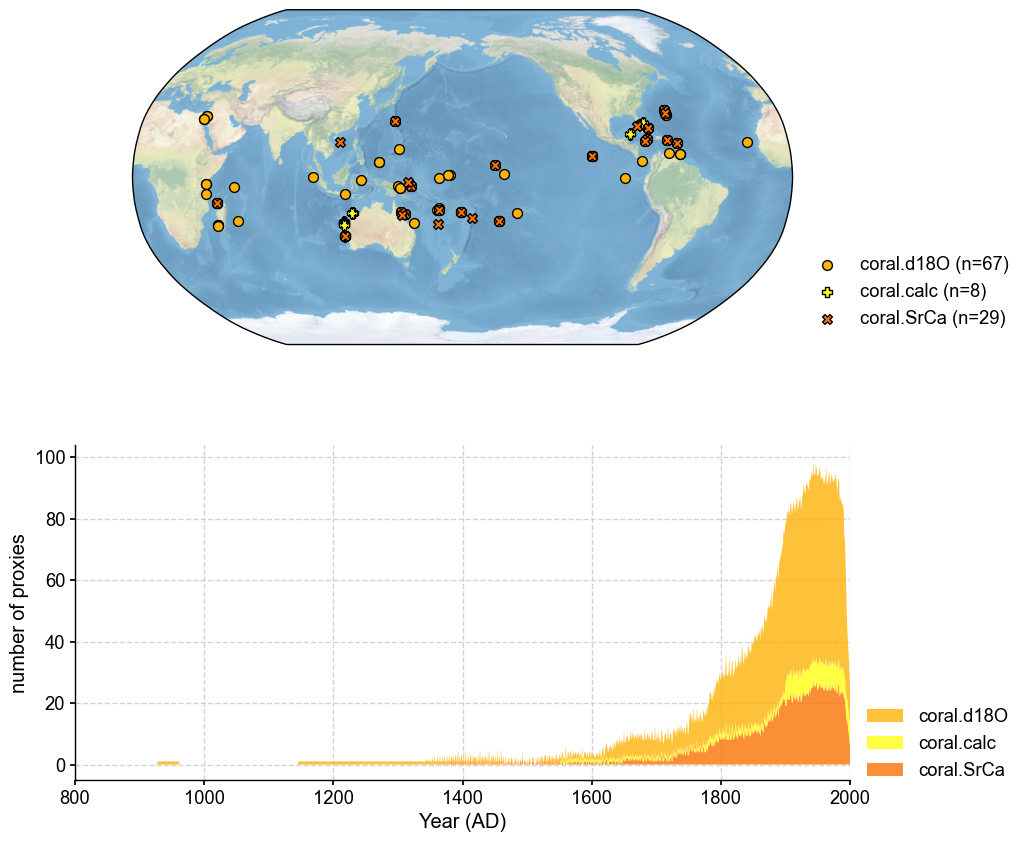
Annualize each proxy record#
[3]:
job.annualize_proxydb(months=[12, 1, 2], verbose=True)
>>> job.configs["annualize_proxydb_months"] = [12, 1, 2]
>>> job.configs["annualize_proxydb_ptypes"] = {'coral.SrCa', 'coral.calc', 'coral.d18O'}
Annualizing ProxyDatabase: 100%|██████████| 104/104 [00:01<00:00, 68.44it/s]
>>> 99 records remaining
>>> job.proxydb updated
Load the instrumental observations#
As a perfect model prior pseudoproxy experiment (PPE), we use the iCESM simulated fields as instrumental observations.
[4]:
job.load_clim(
tag='obs',
path_dict={
'tas': 'gistemp1200_GHCNv4_ERSSTv5', # load from the cloud
},
rename_dict={'tas': 'tempanomaly'},
anom_period=(1951, 1980),
load=True, # load the data into memeory to accelerate the later access; requires large memeory
verbose=True,
)
>>> job.configs["obs_path"] = {'tas': 'gistemp1200_GHCNv4_ERSSTv5'}
>>> job.configs["obs_rename_dict"] = {'tas': 'tempanomaly'}
>>> job.configs["obs_anom_period"] = [1951, 1980]
>>> job.configs["obs_lat_name"] = lat
>>> job.configs["obs_lon_name"] = lon
>>> job.configs["obs_time_name"] = time
>>> The target file seems existed at: ./data/gistemp1200_GHCNv4_ERSSTv5.nc.gz . Loading from it instead of downloading ...
>>> obs variables ['tas'] loaded
>>> job.obs created
Annualize the observation fields#
This step will determine the temporal resolution of the reconstructed fields.
[5]:
job.annualize_clim(tag='obs', verbose=True, months=[12, 1, 2])
>>> job.configs["obs_annualize_months"] = [12, 1, 2]
>>> Processing tas ...
>>> job.obs updated
Regrid the observation fields#
This step will determine the spatial resolution of the reconstructed fields.
[6]:
job.regrid_clim(tag='obs', nlat=42, nlon=63, verbose=True)
>>> job.configs["obs_regrid_nlat"] = 42
>>> job.configs["obs_regrid_nlon"] = 63
>>> Processing tas ...
Crop the observations fields to make the problem size smaller#
[7]:
job.crop_clim(tag='obs', lat_min=-20, lat_max=20, lon_min=150, lon_max=260, verbose=True)
>>> job.configs["obs_lat_min"] = -20
>>> job.configs["obs_lat_max"] = 20
>>> job.configs["obs_lon_min"] = 150
>>> job.configs["obs_lon_max"] = 260
>>> Processing tas ...
[8]:
# check the cropped domain
fig, ax = job.obs['tas'][-1].plot()
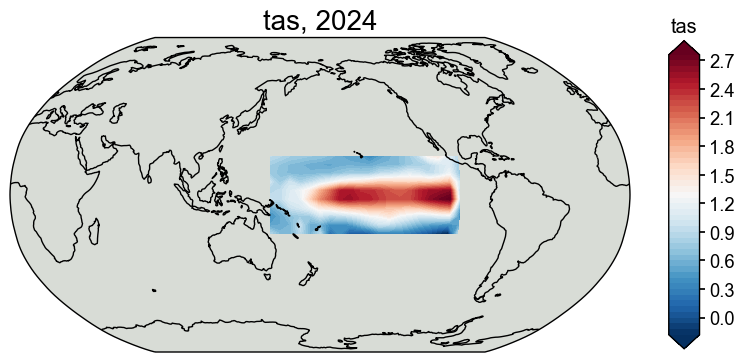
(Optional) Save the job object for later reload#
Save the job object before running the DA procedure for a quick reload next time if needed.
[9]:
job.save('./cases/graphem-real-pages2k', verbose=True)
>>> job.configs["save_dirpath"] = ./cases/graphem-real-pages2k
>>> obs_tas saved to: ./cases/graphem-real-pages2k/obs_tas.nc
>>> job saved to: ./cases/graphem-real-pages2k/job.pkl
Now let’s reload the job object from the saved directory.
[10]:
job = cfr.ReconJob()
job.load('./cases/graphem-real-pages2k/', verbose=True)
>>> job is loaded
>>> job.obs["tas"].da is loaded
Prepare the GraphEM solver#
[11]:
job.prep_graphem(
recon_period=(1871, 2000), # period to reconstruct
calib_period=(1901, 2000), # period for calibration
uniform_pdb=True, # filter the proxydb to be more uniform
verbose=True,
)
>>> job.configs["recon_period"] = [1871, 2000]
>>> job.configs["recon_timescale"] = 1
>>> job.configs["calib_period"] = [1901, 2000]
>>> job.configs["uniform_pdb"] = True
>>> ProxyDatabase filtered to be more uniform. 54 records remaining.
>>> job.configs["proxydb_center_ref_period"] = [1901, 2000]
Centering each of the ProxyRecord: 100%|██████████| 54/54 [00:00<00:00, 2693.26it/s]
>>> job.proxydb updated
>>> job.graphem_params["recon_time"] created
>>> job.graphem_params["calib_time"] created
>>> job.graphem_params["field_obs"] created
>>> job.graphem_params["calib_idx"] created
>>> job.graphem_params["field"] created
>>> job.graphem_params["df_proxy"] created
>>> job.graphem_params["proxy"] created
>>> job.graphem_params["lonlat"] created
Run the GraphEM solver#
We will take the Empirical Graphs (graphical lasso, glasso) approach.
[12]:
job.run_graphem(
save_dirpath='./recons/graphem-real-pages2k',
graph_method='hybrid',
cutoff_radius=5000,
sp_FF=2, sp_FP=2,
verbose=True,
)
>>> job.configs["compress_params"] = {'zlib': True}
>>> job.configs["save_dirpath"] = ./recons/graphem-real-pages2k
>>> job.configs["save_filename"] = job_r01_recon.nc
>>> job.configs["graph_method"] = hybrid
>>> job.configs["cutoff_radius"] = 5000
>>> job.configs["sp_FF"] = 2
>>> job.configs["sp_FP"] = 2
Computing a neighborhood graph with R = 5000.0 km
Estimating graph using neighborhood method
Running GraphEM:
EM | dXmis: 0.0024; rdXmis: 0.0047: 12%|█▎ | 25/200 [00:11<01:17, 2.26it/s]
GraphEM.EM(): Tolerance achieved.
Solving graphical LASSO using greedy search
graph_greedy_search | FF: 2.551; FP: 1.974; PP: 0.000: 3%|▎ | 15/500 [00:01<00:38, 12.59it/s]
Using specified graph
Running GraphEM:
EM | dXmis: 0.0020; rdXmis: 0.0043: 14%|█▎ | 27/200 [00:28<03:02, 1.06s/it]
GraphEM.EM(): Tolerance achieved.
>>> job.graphem_solver created and saved to: None
>>> job.recon_fields created
>>> Reconstructed fields saved to: ./recons/graphem-real-pages2k/job_r01_recon.nc
Validation steps#
Create the reconstruction result object cfr.ReconRes.#
A cfr.ReconRes object takes care of the workflow of postprocessing and analyzing the reconstruction results. It provides handy methods to help the users load, validate, and visualize the reconstruction results.
[13]:
res = cfr.ReconRes('./recons/graphem-real-pages2k', verbose=True)
>>> res.paths:
['./recons/graphem-real-pages2k/job_r01_recon.nc']
Load the reconstructed variables#
Here we validate the tas field and the NINO3.4 index as an example.
[14]:
res.load(['tas', 'nino3.4'], verbose=True)
>>> ReconRes.recons["tas"] created
>>> ReconRes.da["tas"] created
>>> ReconRes.recons["nino3.4"] created
>>> ReconRes.da["nino3.4"] created
Validate the reconstructed NINO3.4#
We calculate the annualized NINO3.4 from Bunge & Clarke (2009) as a reference for validation.
[15]:
bc09 = cfr.EnsTS().fetch('BC09_NINO34').annualize(months=[12, 1, 2])
We use a chain calling of several methods, including the validation step .validate() and the plotting step .plot_qs().
[16]:
fig, ax = res.recons['nino3.4'].compare(bc09, timespan=(1874, 1900)).plot(label='recon')
ax.set_xlim(1870, 1900)
ax.set_ylim(-3, 4)
ax.set_ylabel('NINO3.4 [K]')
cfr.showfig(fig)
cfr.savefig(fig, f'./figs/graphem_corr_recon_BC09.pdf')
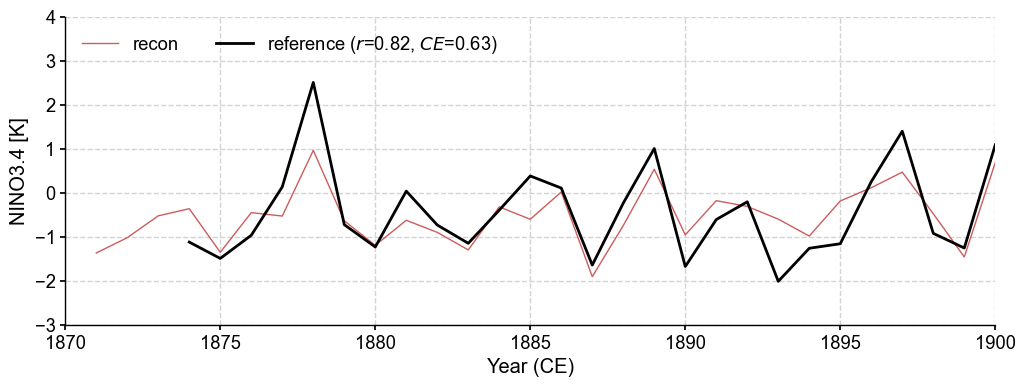
Figure saved at: "figs/graphem_corr_recon_BC09.pdf"
Validate the reconstructed fields#
[17]:
target = cfr.ClimateField().fetch('HadCRUT4.6_GraphEM', vn='tas').get_anom((1951, 1980)).annualize(months=[12, 1, 2])
>>> The target file seems existed at: ./data/HadCRUT4.6_GraphEM_median.nc . Loading from it instead of downloading ...
Calculating and visualizing the correlation coefficient (\(r\)) between the reconstructed and target fields, we see overall high skills.
[18]:
# validate the reconstruction against 20CR
stat = 'corr'
valid_fd = res.recons['tas'].compare(
target, stat=stat,
timespan=(1874, 1900),
)
valid_fd.plot_kwargs.update({'cbar_orientation': 'horizontal', 'cbar_pad': 0.1})
fig, ax = valid_fd.plot(
title=f'{stat}(recon, obs), mean={valid_fd.geo_mean().value[0,0]:.2f}',
projection='PlateCarree',
latlon_range=(-25, 25, 0, 360),
# latlon_range=(-20, 20, 150, 256),
plot_cbar=True, plot_proxydb=True, proxydb=job.proxydb,
plot_proxydb_lgd=True, proxydb_lgd_kws={'loc': 'lower left', 'bbox_to_anchor': (1, 0)},
)
cfr.showfig(fig)
cfr.savefig(fig, f'./figs/graphem_{stat}_recon_obs.pdf')

Figure saved at: "figs/graphem_corr_recon_obs.pdf"
Comparison to the LMR/PDA based reconstruction#
[19]:
res_lmr = cfr.ReconRes('./recons/lmr-real-pages2k', verbose=True)
res_graphem = cfr.ReconRes('./recons/graphem-real-pages2k', verbose=True)
>>> res.paths:
['./recons/lmr-real-pages2k/job_r01_recon.nc', './recons/lmr-real-pages2k/job_r02_recon.nc', './recons/lmr-real-pages2k/job_r03_recon.nc', './recons/lmr-real-pages2k/job_r04_recon.nc', './recons/lmr-real-pages2k/job_r05_recon.nc', './recons/lmr-real-pages2k/job_r06_recon.nc', './recons/lmr-real-pages2k/job_r07_recon.nc', './recons/lmr-real-pages2k/job_r08_recon.nc', './recons/lmr-real-pages2k/job_r09_recon.nc', './recons/lmr-real-pages2k/job_r10_recon.nc']
>>> res.paths:
['./recons/graphem-real-pages2k/job_r01_recon.nc']
[20]:
tas_HadCRUT = cfr.ClimateField().fetch('HadCRUT4.6_GraphEM', vn='tas').get_anom((1951, 1980)).annualize(months=[12, 1, 2])
nino34_bc09 = cfr.EnsTS().fetch('BC09_NINO34').annualize(months=[12, 1, 2])
>>> The target file seems existed at: ./data/HadCRUT4.6_GraphEM_median.nc . Loading from it instead of downloading ...
[21]:
res_graphem.valid(
target_dict={'tas': tas_HadCRUT, 'nino3.4': nino34_bc09},
timespan=(1874, 1900), verbose=True,
stat=['corr', 'CE'],
)
>>> ReconRes.recons["tas"] created
>>> ReconRes.da["tas"] created
>>> ReconRes.recons["nino3.4"] created
>>> ReconRes.da["nino3.4"] created
>>> Validating variable: tas ...
>>> ReconRes.valid_fd[tas_corr] created
>>> ReconRes.valid_fd[tas_CE] created
>>> Validating variable: nino3.4 ...
>>> ReconRes.valid_ts[nino3.4] created
[22]:
res_lmr.valid(
target_dict={'tas': tas_HadCRUT, 'nino3.4': nino34_bc09},
timespan=(1874, 1900), verbose=True,
stat=['corr', 'CE'],
)
>>> ReconRes.recons["tas"] created
>>> ReconRes.da["tas"] created
>>> ReconRes.recons["nino3.4"] created
>>> ReconRes.da["nino3.4"] created
>>> Validating variable: tas ...
>>> ReconRes.valid_fd[tas_corr] created
>>> ReconRes.valid_fd[tas_CE] created
>>> Validating variable: nino3.4 ...
>>> ReconRes.valid_ts[nino3.4] created
[23]:
fig, ax = res_graphem.plot_valid(
target_name_dict={'tas': 'HadCRUT4.6', 'nino3.4': 'BC09'},
recon_name_dict={'tas': 'GraphEM/tas', 'nino3.4': 'NINO3.4 [K]'},
valid_fd_kws=dict(
projection='PlateCarree',
latlon_range=(-17, 17, 153, 252),
plot_cbar=True,
),
valid_ts_kws=dict(
xlim = (1870, 1900),
ylim = (-3, 4),
)
)
cfr.visual.add_annotation(ax, fs=[20, 20, 20])
for k, v in fig.items():
cfr.showfig(v)
cfr.savefig(v, f'./figs/graphem_{k}.pdf')
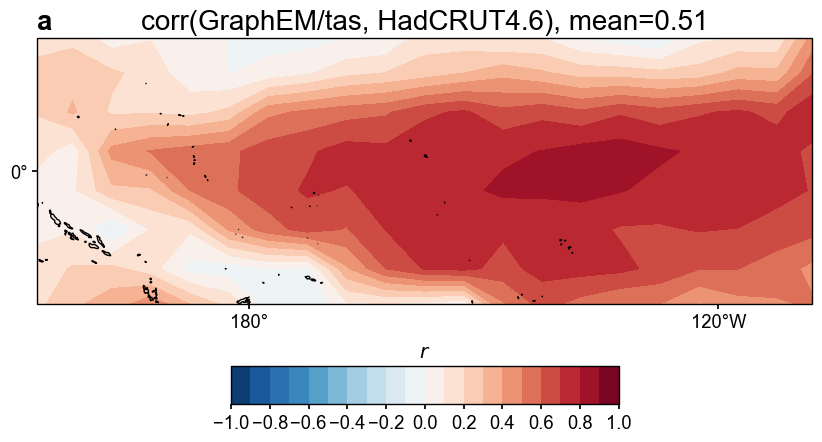


Figure saved at: "figs/graphem_tas_corr.pdf"
Figure saved at: "figs/graphem_tas_CE.pdf"
Figure saved at: "figs/graphem_nino3.4.pdf"
[24]:
fig, ax = res_lmr.plot_valid(
target_name_dict={'tas': 'HadCRUT4.6', 'nino3.4': 'BC09'},
recon_name_dict={'tas': 'PDA/tas', 'nino3.4': 'NINO3.4 [K]'},
valid_fd_kws=dict(
projection='PlateCarree',
latlon_range=(-17, 17, 153, 252),
plot_cbar=True,
),
valid_ts_kws=dict(
xlim = (1870, 1900),
ylim = (-3, 4),
)
)
cfr.visual.add_annotation(ax, fs=[20, 20, 20], start=3)
for k, v in fig.items():
cfr.showfig(v)
cfr.savefig(v, f'./figs/lmr_{k}.pdf')

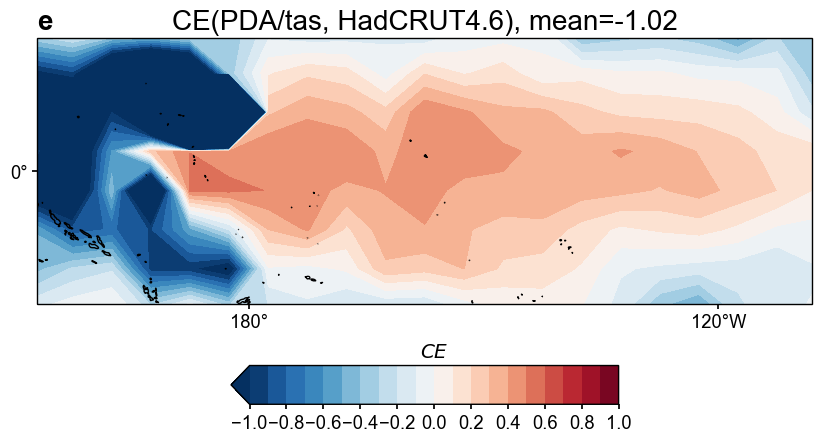
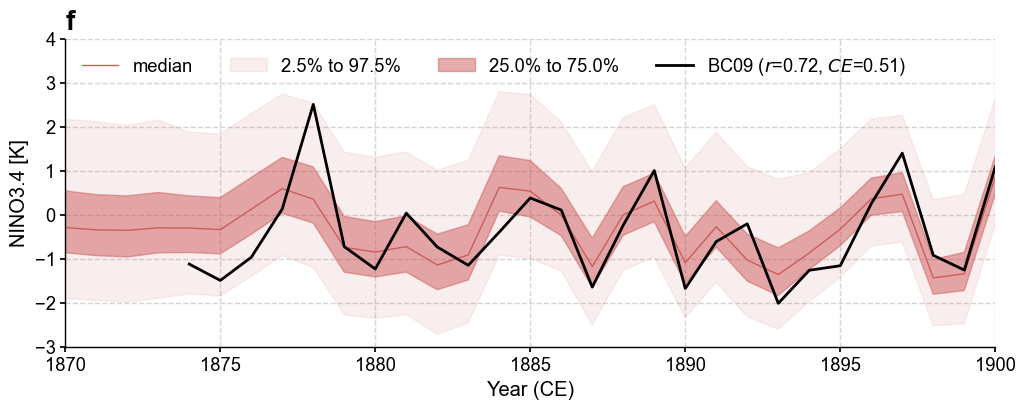
Figure saved at: "figs/lmr_tas_corr.pdf"
Figure saved at: "figs/lmr_tas_CE.pdf"
Figure saved at: "figs/lmr_nino3.4.pdf"
[ ]:
